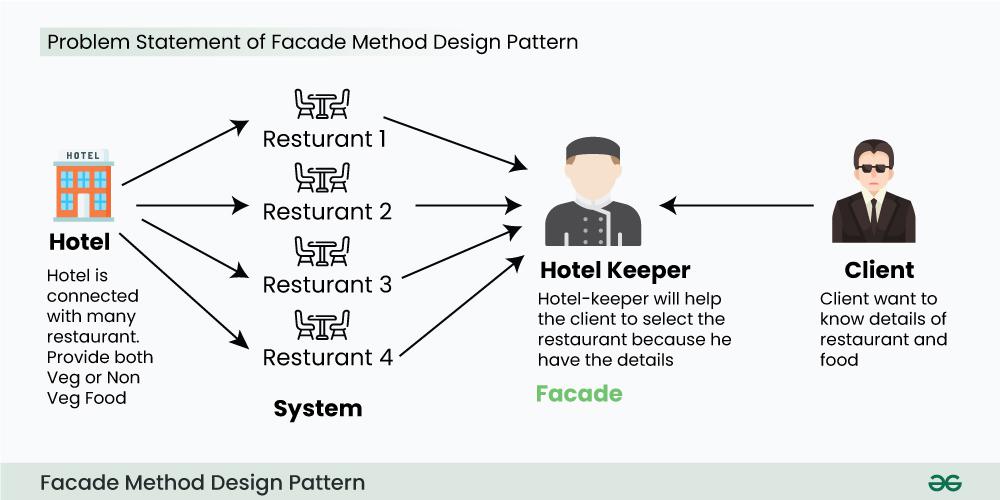Façade pattern
The objective of this post is to explain and show how to implement the Façade Pattern in a basic way.
Pre-requisites
Check all the description and information related to the Façade Pattern and return here to see a practical example.
Description

Image taken from GeekForGeeks
Imagine that you want to process multimedia like videos and images using FFmpeg.
During your development you found that your library just executes FFmpeg and run a command, but your clients don't like this idea because they manually need to create the command and make all the validations to the file,
for example you want you join two videos intro.mp4 and ending.mp4 but you need to validate that they have the same codecs, the same resolution, the output file result.mp4 cannot exists, and the destination path where the program is going to save the file has the right permissions (read and write).
That's a long process, at the end you have a huge piece of code like this:
if (inputFilePaths == null || inputFilePaths.Length == 0)
{
throw new ArgumentException("Input file paths cannot be null or empty.", nameof(inputFilePaths));
}
if (string.IsNullOrEmpty(outputFilePath))
{
throw new ArgumentNullException(nameof(outputFilePath));
}
ValidatePaths(inputFilePaths, outputFilePath, overrideFile);
_fileValidator.EnsureDirectoryPathExists(outputFilePath);
var firstVideoInfo = _videoInfoProcessor.GetVideoInfo(inputFilePaths[0]);
for (int i = 1; i < inputFilePaths.Length; i++)
{
var videoInfo = _videoInfoProcessor.GetVideoInfo(inputFilePaths[i]);
if (videoInfo.Width != firstVideoInfo.Width || videoInfo.Height != firstVideoInfo.Height)
{
throw new DifferentResolutionsException("Videos have different resolutions. Concatenation is not supported.");
}
}
string inputFiles = string.Join(" ", inputFilePaths.Select(path => $"-i \"{path}\""));
var arguments = $" {inputFiles} -filter_complex \"";
if (includeAudio)
{
for (int i = 0; i < inputFilePaths.Length; i++)
{
var videoInfo = _videoInfoProcessor.GetVideoInfo(inputFilePaths[i]);
arguments += $"[{i}:v] [{i}:a]";
}
arguments += $" concat=n={inputFilePaths.Length}:v=1:a=1 [v] [a]\"";
}
else
{
for (int i = 0; i < inputFilePaths.Length; i++)
{
arguments += $"[{i}:v]";
}
arguments += $" concat=n={inputFilePaths.Length}:v=1 [v]\"";
}
arguments += $" -map \"[v]\"";
if (includeAudio)
{
arguments += $" -map \"[a]\"";
}
arguments += $" \"{outputFilePath}\"";
arguments += overrideFile ? " -y" : " -n";
var result = _executor.ExecuteCommand(FFmpegConfig.GetFFmpegLocation(), arguments);
if (!string.IsNullOrEmpty(result) && result.Contains("Error:"))
{
throw new FFmpegException($"Error concatenating videos: {result}");
}
That's a lot of code, there are too many things to do just for joining videos, and your clients, the developers that want to use your library don't expect to make everything, they just need to join videos they don't want to know what happens inside your code to do something like that, they just want to use it:
var paths = new string[] { "G:\\Videos\\intro.mp4", "J:\\Downloads\\ending.mp4" };
videoTranscoder.ConcatenateVideos(paths, "J:\\Documents\\result.mp4", overrideFile: true);
How to put it into practice?
You have to create a common class or interface where you expose all the definitions of your methods but not the implementation, in the current example we have the VideoTranscodingProcessor which implements the IVideoTranscodingProcessor
your users don't want to know what the VideoTranscodingProcessor contains they just want to use the IVideoTranscodingProcessor and call its methods.
Code Implementation
To implement this pattern you have to define your common interface, in this case the IVideoTranscodingProcessor that's our façade
public interface IVideoTranscodingProcessor
{
void TranscodeVideo(string inputFilePath, string outputFilePath, VideoCodec videoEncoder = VideoCodec.H264, AudioCodec audioEncoder = AudioCodec.AAC, int audioBitrate = 128, bool overrideFile = false);
void ChangeVideoResolution(string inputFilePath, string outputFilePath, int newWidth, int newHeight, bool overrideFile = false);
void SetVideoFrameRate(string inputFilePath, string outputFilePath, int frameRate, bool overrideFile = false);
void ConcatenateVideos(string[] inputFilePaths, string outputFilePath, bool includeAudio = true, bool overrideFile = false);
void ChangeAspectRatio(string inputFilePath, string outputFilePath, AspectRatio aspectRatio, bool overrideFile = false);
}
After that you have to create your implementation of the façade, in our example is the VideoTranscodingProcessor that has all the logic like validation, calling external services, creating the commands and executing the commands.
Please visit the source code for the implementation of VideoTranscodingProcessor
Finally we have the client, which is responsible for calling our façades and calling the methods.
var serviceCollection = new ServiceCollection();
ConfigureServices(serviceCollection);
var serviceProvider = serviceCollection.BuildServiceProvider();
var imageInfoProcessor = serviceProvider.GetRequiredService<IImageInfoProcessor>();
var videoTranscoder = serviceProvider.GetRequiredService<IVideoTranscodingProcessor>();
var videoInfoProcessor = serviceProvider.GetRequiredService<IVideoInfoProcessor>();
var imageInfo = imageInfoProcessor.GetImageInfo("J:\\Pictures\\31bff16c98b1fa974674d7d21e7c256a.jpg");
Console.WriteLine($"Width: {imageInfo.Width}, Height: {imageInfo.Height}, Format: {imageInfo.Format}");
videoTranscoder.ChangeVideoResolution("J:\\Downloads\\shooting star de rojas.mp4", "J:\\Downloads\\shooting.mp4", 1440, 1080, overrideFile: true);
var originalVideo = videoInfoProcessor.GetVideoInfo("J:\\Downloads\\shooting star de rojas.mp4");
var newVideo = videoInfoProcessor.GetVideoInfo("J:\\Downloads\\shooting.mp4");
Console.WriteLine(@originalVideo);
Console.WriteLine(@newVideo);
void ConfigureServices(ServiceCollection services)
{
services.AddLogging(configure =>
{
configure.AddConsole();
configure.SetMinimumLevel(LogLevel.Information);
});
services.AddKONMediaProcessor();
}


